Big congratulations to @lscangus Angus, Gary and company! I saw that on a translated version of High Fidelity a couple weeks ago and wasn't sure if it was real. Well deserved recognition!!Angus asked me to post WestminsterLab's recent Award from High Fidelity Magazine, Poland for the Quest
preamplifier and Rei amplifiers. This adds to similar recognition in Mono and Stereo global, HIFI STATEMENT Germany, Stereo Sound and AEX, Japan. We expect to see our first reviews in North America soon.
View attachment 118544
Re-imagining "Class A" Amplification
- Thread starter gleeds
- Start date
You are using an out of date browser. It may not display this or other websites correctly.
You should upgrade or use an alternative browser.
You should upgrade or use an alternative browser.
Westminster on Westminsters, Part I
Earlier this year, I had the opportunity to audition the WestminsterLab REI monoblocks in my system, courtesy of Fred Ainsley (Destination Sound Group) @LampiNA. I strongly believe in home auditions as the gold standard and feel that although you can get a general idea of a component’s sound at the dealer’s listening room or at shows, it is quite hard to predict how something will integrate with the gestalt of your own system and room.
Thanks to the remarkably small and light (relatively speaking) dimensions of the Westminsterlab REIs, it was quite straightforward to be able to directly drop them in my system for a true head to head comparison.
A bit of background on my system as a whole. It is built around a few core components, chief of which are my Tannoy Westminster Golden Reference (GR) speakers. These are two-way, concentric driver horn loaded speakers with specified 99 dB efficiency which I moved to after Avantgarde horns. Second is my beloved Lampizator Horizon DAC, of which much has been written on these forums. Third is my Taiko Extreme Server, where there is also a 1000+ page thread ongoing
My philosophy is to keep the chain as short and simple as possible to minimize coloration and complexity, so in general I have either used a passive/buffered preamp or preferably no preamp. My preference is also to have the amplifiers be as transparent as possible, aside from perhaps a hint of euphony, with the source components dominating the source of any sonic signature.
The incumbent amplifier powering this chain was the well respected Pass Labs XA30.8, which replaced a pair of Art Audio Jota SET monoblocks. The XA30.8 did many things very well, with remarkable soundstaging and tonal density. It had many features of a SET amp, but with more power and less maintenance. Nevertheless, over the years it was clear that despite the 99dB sensitivity rating of the Tannoy Westies, there was significant strain in loud passages and orchestral crescendos, which was my hint that my system could perhaps benefit from a different amplifier selection.
So when Fred started raving about a new set of amps last year, I sat up and took notice. How would these WestminsterLab amps do with my Westminsters? Were the names a serendipitous sign of sonic conceptual consanguinity?
Continued in Part II
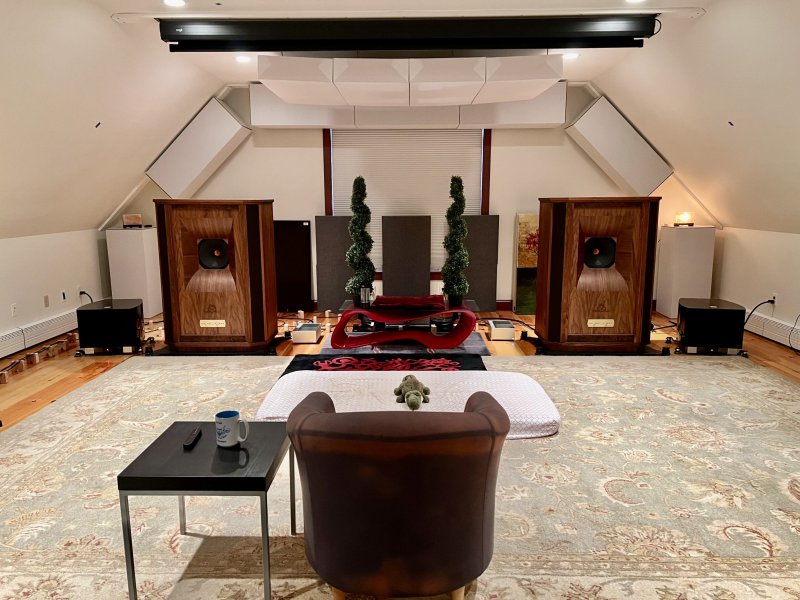
Earlier this year, I had the opportunity to audition the WestminsterLab REI monoblocks in my system, courtesy of Fred Ainsley (Destination Sound Group) @LampiNA. I strongly believe in home auditions as the gold standard and feel that although you can get a general idea of a component’s sound at the dealer’s listening room or at shows, it is quite hard to predict how something will integrate with the gestalt of your own system and room.
Thanks to the remarkably small and light (relatively speaking) dimensions of the Westminsterlab REIs, it was quite straightforward to be able to directly drop them in my system for a true head to head comparison.
A bit of background on my system as a whole. It is built around a few core components, chief of which are my Tannoy Westminster Golden Reference (GR) speakers. These are two-way, concentric driver horn loaded speakers with specified 99 dB efficiency which I moved to after Avantgarde horns. Second is my beloved Lampizator Horizon DAC, of which much has been written on these forums. Third is my Taiko Extreme Server, where there is also a 1000+ page thread ongoing
My philosophy is to keep the chain as short and simple as possible to minimize coloration and complexity, so in general I have either used a passive/buffered preamp or preferably no preamp. My preference is also to have the amplifiers be as transparent as possible, aside from perhaps a hint of euphony, with the source components dominating the source of any sonic signature.
The incumbent amplifier powering this chain was the well respected Pass Labs XA30.8, which replaced a pair of Art Audio Jota SET monoblocks. The XA30.8 did many things very well, with remarkable soundstaging and tonal density. It had many features of a SET amp, but with more power and less maintenance. Nevertheless, over the years it was clear that despite the 99dB sensitivity rating of the Tannoy Westies, there was significant strain in loud passages and orchestral crescendos, which was my hint that my system could perhaps benefit from a different amplifier selection.
So when Fred started raving about a new set of amps last year, I sat up and took notice. How would these WestminsterLab amps do with my Westminsters? Were the names a serendipitous sign of sonic conceptual consanguinity?
Continued in Part II

Westminster on Westminsters, Part II
Enter the REIs. They arrived in boxes seemingly more suited for a router or LPSU rather than amps capable of this power output – a huge plus for me given my history of back injury. In the flesh, the REIs seemed like little jewel boxes of rarefied workmanship, and also significantly denser than I expected. Fit and finish were impeccable, with elegant and minimalist lines recalling Angus’ training as a architect. Fitting them into my system for the audition, I ran into my first dilemma. The REIs only have the option for a XLR balanced input. My system has been single ended through the Lampizator Big 7, GG, GG2, Pacific but now with the Horizon I had balanced operation available. The XA30.8 had both SE and XLR inputs, so to keep a level playing field, I decided to do most of my comparisons in balanced mode for both amps.
I am also an advocate of the maxim not to put your component rack between your speakers (credit to Jim Smith where I first learned this, whether or not he was the first to come up with it). At the time of audition, I had all my components on a rack directly to the left of the listening position, against the left wall. As my system was single ended at that time, I had very long (30’) speaker cables; running a 30’ length of SE interconnects would expose me to RF and noise pickup.
I was warned by Fred (and indirectly Gary @gleeds) that this would mask the true performance of the REI monoblocks, but in the interest of keeping everything the same as much as possible for a semi-scientific experiment, I maintained the same connections throughout the audition, with short interconnects and very long speaker cables.
Lots of time was allowed for burn in of the XLR connectors and circuits on my Horizon to both the XA30.8 and the REIs. But even from the first notes, it was clear that Angus has created something special. In psychology numerous studies have been published indicating that your first impressions of a new acquaintance are formed in 100 – 500 milliseconds. In my field of radiology there are informal studies showing that most experienced radiologists can pick up most findings on a CT scan within 2 seconds. Whether this is true with audio is harder to say, since different recordings test such different aspects of equipment performance. With this in mind, the first two immediate impressions that sprung to mind with the REIs in place were clarity and limitless ease.
Clarity:
I would have never characterized the XA30.8 as being veiled or hazy. But with the REIs swapped in, there was the persistent and reproducible impression that the sonic window had been thoroughly Windex-ed; or for those of you eyeglass wearers, how you feel after your glasses have been meticulously cleaned after a long and arduous day. This Is undoubtedly a worn out audiophile trope. Nevertheless it is the best analogy for what I heard. This all contributed in an organic manner to perfecting the sonic illusion.
Limitless Ease:
This was the whole reason that I needed a reconfiguration. In my old setup, small combos, jazz, blues, chamber music were all compelling and realistic. However, with any complex orchestral or voice crescendos, there was a perceptible hardening and glare that set in with the Pass amp. This was completely gone with the REIs and not only that, all signs of strain and fatigue were now absent.
A substantial portion of my listening time is spent on classical music and opera. My benchmarks for live classical performances have been set over numerous (20-30/year) concerts at the Boston Symphony Hall, thanks to the College Rush ticket program while I was in med/grad school on the HMS quad. My preferred seating position is very close to the stage, at rows C or D, with the visceral impact and detail that a front orchestra seat provides, albeit at the cost of some integration of the musical whole. For me, the emotionality of the music comes through best in that location. The Boston Symphony Hall is also well recognized as one of the best sounding concert halls in existence.
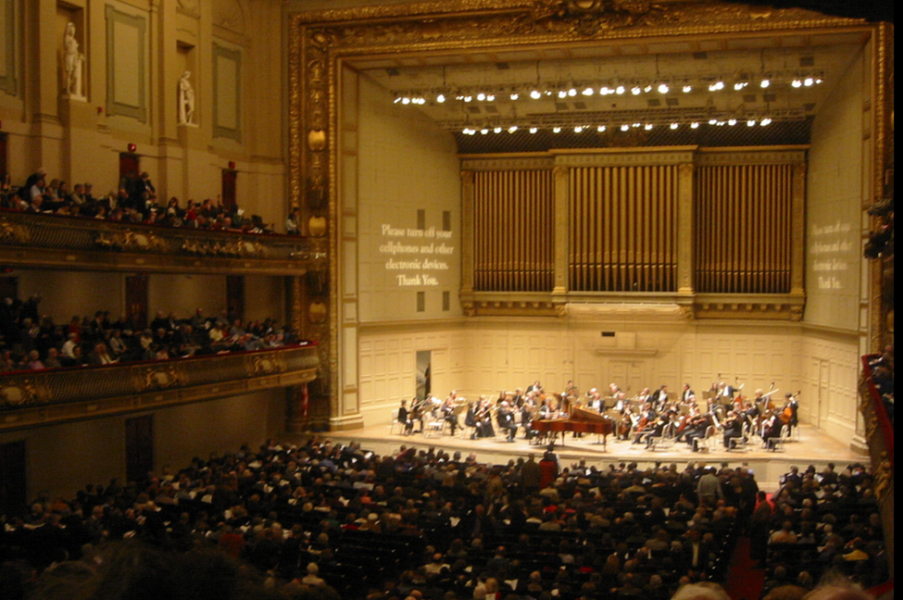 Credit Wikipedia
Credit Wikipedia
My far and away #1 musical experience was with Karita Mattila and the BSO under James Levine performing the final scene of Salome: “Ah! Ich habe deinen Mund geküsst, Jochanaan”. I was seated in B19, 25’ in front of Karita with a clear visual and sonic path between us. The intensity of the music and her singing was such that I nearly passed out, the one and only time this has happened.
I’ve been trying to recreate an approximation of this and other concert experiences seated close to the orchestra. In some ways, turning up the volume should bring your sonic perspective closer to the stage, but with many systems (including my own prior to the arrival of the REIs) the whole presentation falls apart in believability for me as you approach virtual row H or G, even though the system is perfectly capable of painting a remarkably realistic soundscape from mid-rear orchestra and upper tier/balcony levels, when the volume is lower.
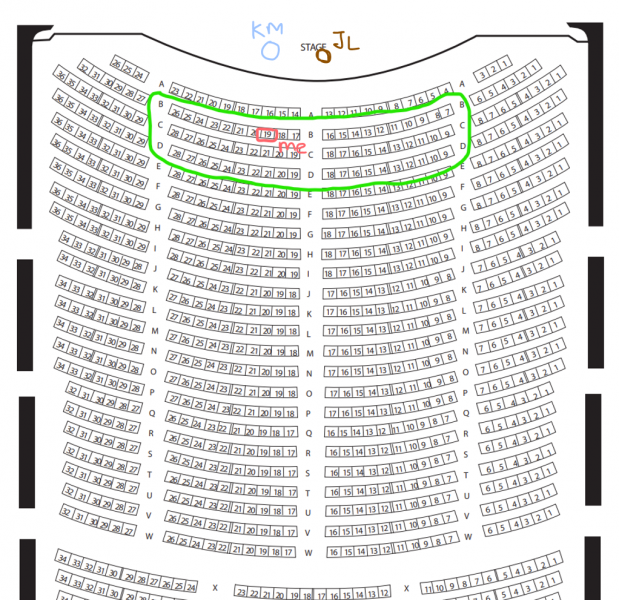
The REIs changed all this. With each step up in volume on the Horizon, I now feel like I am being seamlessly teleported forwards in hall position and perspective. Not only are the dynamics and SPLs increasing in a highly realistic fashion, but the soundstage is enlarging from side to side to become enveloping. Orchestral ff and fff are rendered without any hint of harshness, strain nor fatigue, a smooth wall of sound vibrating your body; whereas the gentlest ppp passages demonstrate wonderful delicacy and detail.
Below is my fanciful schematic rendition of what the volume up and volume down does, with XA30.8 and all prior amps in my system on the left, and the REI on the right. The REI’s ability to smoothly shift my sonic perspective to almost every position in the concert hall is unparalleled.
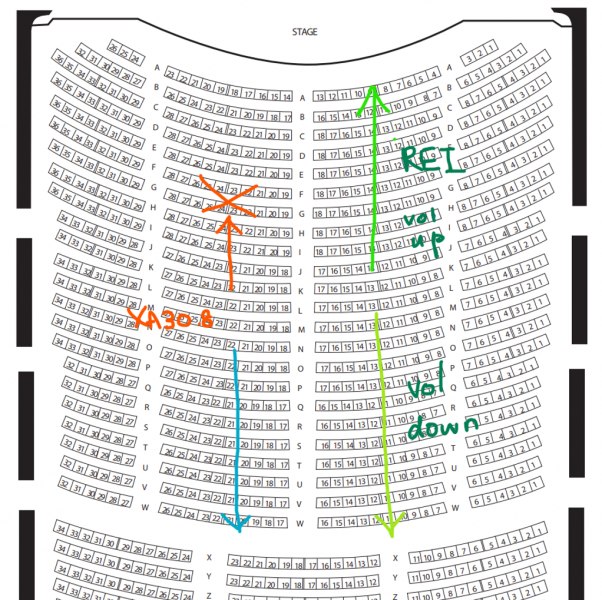
Continued in Part III
Enter the REIs. They arrived in boxes seemingly more suited for a router or LPSU rather than amps capable of this power output – a huge plus for me given my history of back injury. In the flesh, the REIs seemed like little jewel boxes of rarefied workmanship, and also significantly denser than I expected. Fit and finish were impeccable, with elegant and minimalist lines recalling Angus’ training as a architect. Fitting them into my system for the audition, I ran into my first dilemma. The REIs only have the option for a XLR balanced input. My system has been single ended through the Lampizator Big 7, GG, GG2, Pacific but now with the Horizon I had balanced operation available. The XA30.8 had both SE and XLR inputs, so to keep a level playing field, I decided to do most of my comparisons in balanced mode for both amps.
I am also an advocate of the maxim not to put your component rack between your speakers (credit to Jim Smith where I first learned this, whether or not he was the first to come up with it). At the time of audition, I had all my components on a rack directly to the left of the listening position, against the left wall. As my system was single ended at that time, I had very long (30’) speaker cables; running a 30’ length of SE interconnects would expose me to RF and noise pickup.
I was warned by Fred (and indirectly Gary @gleeds) that this would mask the true performance of the REI monoblocks, but in the interest of keeping everything the same as much as possible for a semi-scientific experiment, I maintained the same connections throughout the audition, with short interconnects and very long speaker cables.
Lots of time was allowed for burn in of the XLR connectors and circuits on my Horizon to both the XA30.8 and the REIs. But even from the first notes, it was clear that Angus has created something special. In psychology numerous studies have been published indicating that your first impressions of a new acquaintance are formed in 100 – 500 milliseconds. In my field of radiology there are informal studies showing that most experienced radiologists can pick up most findings on a CT scan within 2 seconds. Whether this is true with audio is harder to say, since different recordings test such different aspects of equipment performance. With this in mind, the first two immediate impressions that sprung to mind with the REIs in place were clarity and limitless ease.
Clarity:
I would have never characterized the XA30.8 as being veiled or hazy. But with the REIs swapped in, there was the persistent and reproducible impression that the sonic window had been thoroughly Windex-ed; or for those of you eyeglass wearers, how you feel after your glasses have been meticulously cleaned after a long and arduous day. This Is undoubtedly a worn out audiophile trope. Nevertheless it is the best analogy for what I heard. This all contributed in an organic manner to perfecting the sonic illusion.
Limitless Ease:
This was the whole reason that I needed a reconfiguration. In my old setup, small combos, jazz, blues, chamber music were all compelling and realistic. However, with any complex orchestral or voice crescendos, there was a perceptible hardening and glare that set in with the Pass amp. This was completely gone with the REIs and not only that, all signs of strain and fatigue were now absent.
A substantial portion of my listening time is spent on classical music and opera. My benchmarks for live classical performances have been set over numerous (20-30/year) concerts at the Boston Symphony Hall, thanks to the College Rush ticket program while I was in med/grad school on the HMS quad. My preferred seating position is very close to the stage, at rows C or D, with the visceral impact and detail that a front orchestra seat provides, albeit at the cost of some integration of the musical whole. For me, the emotionality of the music comes through best in that location. The Boston Symphony Hall is also well recognized as one of the best sounding concert halls in existence.
 Credit Wikipedia
Credit WikipediaMy far and away #1 musical experience was with Karita Mattila and the BSO under James Levine performing the final scene of Salome: “Ah! Ich habe deinen Mund geküsst, Jochanaan”. I was seated in B19, 25’ in front of Karita with a clear visual and sonic path between us. The intensity of the music and her singing was such that I nearly passed out, the one and only time this has happened.
I’ve been trying to recreate an approximation of this and other concert experiences seated close to the orchestra. In some ways, turning up the volume should bring your sonic perspective closer to the stage, but with many systems (including my own prior to the arrival of the REIs) the whole presentation falls apart in believability for me as you approach virtual row H or G, even though the system is perfectly capable of painting a remarkably realistic soundscape from mid-rear orchestra and upper tier/balcony levels, when the volume is lower.

The REIs changed all this. With each step up in volume on the Horizon, I now feel like I am being seamlessly teleported forwards in hall position and perspective. Not only are the dynamics and SPLs increasing in a highly realistic fashion, but the soundstage is enlarging from side to side to become enveloping. Orchestral ff and fff are rendered without any hint of harshness, strain nor fatigue, a smooth wall of sound vibrating your body; whereas the gentlest ppp passages demonstrate wonderful delicacy and detail.
Below is my fanciful schematic rendition of what the volume up and volume down does, with XA30.8 and all prior amps in my system on the left, and the REI on the right. The REI’s ability to smoothly shift my sonic perspective to almost every position in the concert hall is unparalleled.

Continued in Part III
Fascinating write up! Thanks for taking the time. A few questions:
- Are you contemplating (or would you) doing 2 per channel? I believe they offer that design flexibility
- What Avantgardes did you have before the mighty Tannoys?
- I notice you use REL subs...do you use that for just music as well as cinema...any details on the kind of crossover settings you use?
- Also what happens when you use your dual REL Anniversary subs?
- Enjoy!
- Are you contemplating (or would you) doing 2 per channel? I believe they offer that design flexibility
- What Avantgardes did you have before the mighty Tannoys?
- I notice you use REL subs...do you use that for just music as well as cinema...any details on the kind of crossover settings you use?
- Also what happens when you use your dual REL Anniversary subs?
- Enjoy!
Last edited:
Thank you for taking the time to write this. I have been very happy with the Rei/Quest combo.Westminster on Westminsters, Part I
Earlier this year, I had the opportunity to audition the WestminsterLab REI monoblocks in my system, courtesy of Fred Ainsley (Destination Sound Group) @LampiNA. I strongly believe in home auditions as the gold standard and feel that although you can get a general idea of a component’s sound at the dealer’s listening room or at shows, it is quite hard to predict how something will integrate with the gestalt of your own system and room.
Thanks to the remarkably small and light (relatively speaking) dimensions of the Westminsterlab REIs, it was quite straightforward to be able to directly drop them in my system for a true head to head comparison.
A bit of background on my system as a whole. It is built around a few core components, chief of which are my Tannoy Westminster Golden Reference (GR) speakers. These are two-way, concentric driver horn loaded speakers with specified 99 dB efficiency which I moved to after Avantgarde horns. Second is my beloved Lampizator Horizon DAC, of which much has been written on these forums. Third is my Taiko Extreme Server, where there is also a 1000+ page thread ongoing
My philosophy is to keep the chain as short and simple as possible to minimize coloration and complexity, so in general I have either used a passive/buffered preamp or preferably no preamp. My preference is also to have the amplifiers be as transparent as possible, aside from perhaps a hint of euphony, with the source components dominating the source of any sonic signature.
The incumbent amplifier powering this chain was the well respected Pass Labs XA30.8, which replaced a pair of Art Audio Jota SET monoblocks. The XA30.8 did many things very well, with remarkable soundstaging and tonal density. It had many features of a SET amp, but with more power and less maintenance. Nevertheless, over the years it was clear that despite the 99dB sensitivity rating of the Tannoy Westies, there was significant strain in loud passages and orchestral crescendos, which was my hint that my system could perhaps benefit from a different amplifier selection.
So when Fred started raving about a new set of amps last year, I sat up and took notice. How would these WestminsterLab amps do with my Westminsters? Were the names a serendipitous sign of sonic conceptual consanguinity?
Continued in Part II
View attachment 119338
Wonderful review and I particularly enjoyed your rendering of how the apparent seating position in Boston Symphony Hall moved about with adjustments in volume. I too have the Westminster Lab Rei in our system and share many of the same experiences you have with their addition. I had "trained" myself to believe that performance of this caliber was only achievable with the assistance of a forklift (bigger, heavier, larger lumps of metal). However, when I stopped listening with my eyes the cognitive dissonance of their size relative to their sonic performance ceased to be an impediment.Westminster on Westminsters, Part I
Earlier this year, I had the opportunity to audition the WestminsterLab REI monoblocks in my system, courtesy of Fred Ainsley (Destination Sound Group) @LampiNA. I strongly believe in home auditions as the gold standard and feel that although you can get a general idea of a component’s sound at the dealer’s listening room or at shows, it is quite hard to predict how something will integrate with the gestalt of your own system and room.
Thanks to the remarkably small and light (relatively speaking) dimensions of the Westminsterlab REIs, it was quite straightforward to be able to directly drop them in my system for a true head to head comparison.
A bit of background on my system as a whole. It is built around a few core components, chief of which are my Tannoy Westminster Golden Reference (GR) speakers. These are two-way, concentric driver horn loaded speakers with specified 99 dB efficiency which I moved to after Avantgarde horns. Second is my beloved Lampizator Horizon DAC, of which much has been written on these forums. Third is my Taiko Extreme Server, where there is also a 1000+ page thread ongoing
My philosophy is to keep the chain as short and simple as possible to minimize coloration and complexity, so in general I have either used a passive/buffered preamp or preferably no preamp. My preference is also to have the amplifiers be as transparent as possible, aside from perhaps a hint of euphony, with the source components dominating the source of any sonic signature.
The incumbent amplifier powering this chain was the well respected Pass Labs XA30.8, which replaced a pair of Art Audio Jota SET monoblocks. The XA30.8 did many things very well, with remarkable soundstaging and tonal density. It had many features of a SET amp, but with more power and less maintenance. Nevertheless, over the years it was clear that despite the 99dB sensitivity rating of the Tannoy Westies, there was significant strain in loud passages and orchestral crescendos, which was my hint that my system could perhaps benefit from a different amplifier selection.
So when Fred started raving about a new set of amps last year, I sat up and took notice. How would these WestminsterLab amps do with my Westminsters? Were the names a serendipitous sign of sonic conceptual consanguinity?
Continued in Part II
View attachment 119338
Do you mind sharing the dimensions of the lovely listening room pictured in Part I?
Best- Matt in Colorado
Hi there!Fascinating write up! Thanks for taking the time. A few questions:
- Are you contemplating (or would you) doing 2 per channel? I believe they offer that design flexibility
- What Avantgardes did you have before the mighty Tannoys?
- I notice you use REL subs...do you use that for just music as well as cinema...any details on the kind of crossover settings you use?
- Also what happens when you use your dual REL Anniversary subs?
- Enjoy!
- Yes, I am definitely thinking of aiming for that option down the line. It seems like everyone who has tried 2 REIs/channel have raved about them, including some Japanese audio magazines and the Von Schweikert experience described several pages ago on this thread. Having the option of a stepped upgrade path to maximum performance is pretty great, especially for those of us who cannot afford to go full shebang all at once.
- I had the Avantgarde Unos 2.1. Lived with and loved them for many years; their dynamic prowess was still unmatched, but coherence between the drivers was always an issue, especially with the 225 sub units. That was obviously many generations ago compared to Avantgarde's latest technology, but the move from AG to the Westminsters was really accompanied by a big increase in the sense of naturalness for lack of a better word, as at least in my system at the time, the crazy dynamics and top end detail was "too much of a good thing" so to speak...
- my REL G2s are used for both music and cinema, but my setup is only 2 channel (i guess would this be 2.2 in proper notation)? cinema is significantly lower priority in my system and mainly for noncritical viewing. I'll have to get back to you about the xover settings as I'm not home at the moment, but I partly relied on REW measurements at the listening position to tune the frequency cutoff and gain.
- all of my comments above were made with my REL G2s active. They are connected with speaker level inputs and inherit the sonic signature of the amps used, in this case the REIs as well as the Pass. Comparisons were made without additional adjustments on the RELs as I was trying to change as few variables as possible between tests.
Thanks! Elated with this discovery and acquisition, and happy to share my experiences.
Hi Matt @mxk116!Wonderful review and I particularly enjoyed your rendering of how the apparent seating position in Boston Symphony Hall moved about with adjustments in volume. I too have the Westminster Lab Rei in our system and share many of the same experiences you have with their addition. I had "trained" myself to believe that performance of this caliber was only achievable with the assistance of a forklift (bigger, heavier, larger lumps of metal). However, when I stopped listening with my eyes the cognitive dissonance of their size relative to their sonic performance ceased to be an impediment.
Do you mind sharing the dimensions of the lovely listening room pictured in Part I?
Best- Matt in Colorado
Glad to hear that your own experiences with the REIs also support my findings!
Totally agree with the cognitiive dissonance of their size relative to sonic performance. You actually hit on one of the exact points that I was going to go over later in my writeup... I think for at least some audiophiles the deeply entrenched bias (pun intended) of hot and backbreakingly heavy Class A amps as the only path to acceptable performance results in a counterintuitive disadvantage for the small, light and cool running REIs.
For me, I strove to judge first by sonics alone. Once the sonic superiority was clear, then the small, light and cool running aspects of the design were HUGE benefits to my back, my electric bill, ease of system reconfiguration and the environment!
Thanks for the nice words about my listening room. Certainly budget and space do not allow for a custom designed listening room like many other lucky audiophiles here own, but thanks to an understanding spouse/partner the "bonus room" above the garage is mine to play around with.
Dimensions are 27.3' x 24' x 8.9'. For s**s and giggles, here's are maps of the 70Hz and 112Hz nodes and nulls I did a few years back. I've since added a small-moderate number of bass traps, including the cloud you see in the pic. The 70Hz mode is actually the 1st height mode so the cloud traps are doing the most to tame this. This resulted in a big increase in bass tightness/performance and ambiance reproduction.
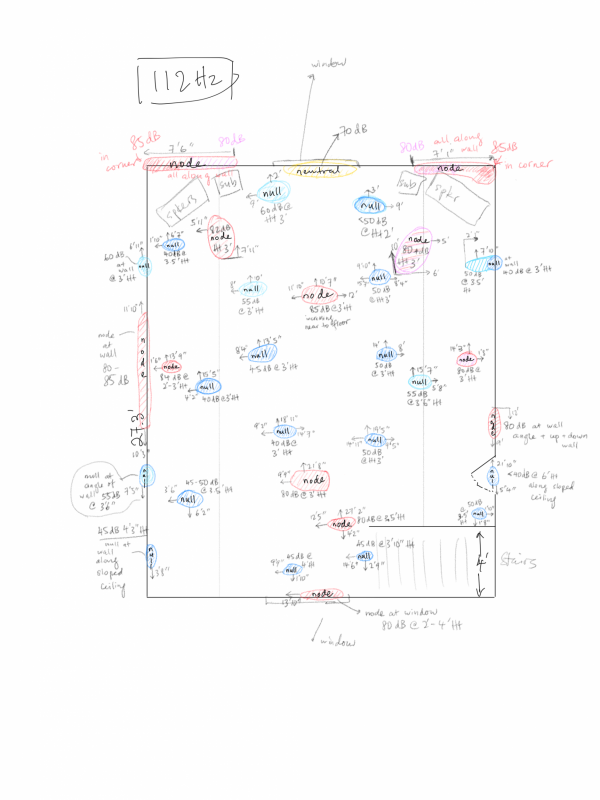
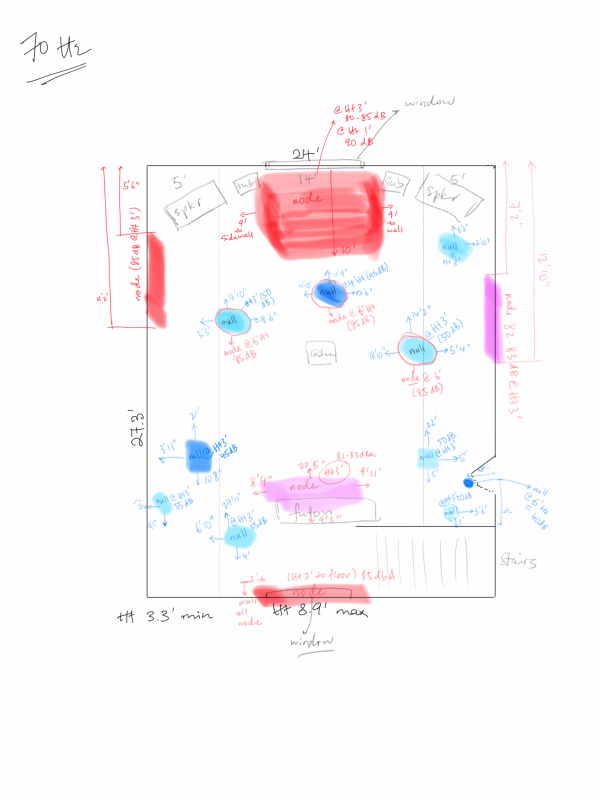
Thank you! Really interesting. Look forward to reading more as you continue to get to know the Westminster REIs.Hi there!
- Yes, I am definitely thinking of aiming for that option down the line. It seems like everyone who has tried 2 REIs/channel have raved about them, including some Japanese audio magazines and the Von Schweikert experience described several pages ago on this thread. Having the option of a stepped upgrade path to maximum performance is pretty great, especially for those of us who cannot afford to go full shebang all at once.
- I had the Avantgarde Unos 2.1. Lived with and loved them for many years; their dynamic prowess was still unmatched, but coherence between the drivers was always an issue, especially with the 225 sub units. That was obviously many generations ago compared to Avantgarde's latest technology, but the move from AG to the Westminsters was really accompanied by a big increase in the sense of naturalness for lack of a better word, as at least in my system at the time, the crazy dynamics and top end detail was "too much of a good thing" so to speak...
- my REL G2s are used for both music and cinema, but my setup is only 2 channel (i guess would this be 2.2 in proper notation)? cinema is significantly lower priority in my system and mainly for noncritical viewing. I'll have to get back to you about the xover settings as I'm not home at the moment, but I partly relied on REW measurements at the listening position to tune the frequency cutoff and gain.
- all of my comments above were made with my REL G2s active. They are connected with speaker level inputs and inherit the sonic signature of the amps used, in this case the REIs as well as the Pass. Comparisons were made without additional adjustments on the RELs as I was trying to change as few variables as possible between tests.
Thanks! Elated with this discovery and acquisition, and happy to share my experiences.
Steve Williams
Site Founder, Site Owner, Administrator
it is my understanding that a recent head to head evaluation between the TOTL Ch Precision mono amps ($220K) and the REI monos, the REI in fact out sounded the uber expensive Ch Precision. I had the mono version of REI in my system and then the bridged set of REI in my system paired against my $150K Pure class A 32 wpm Lamm amps and it was a humbling experience. I am a tube guy for the past 25 years and love my system but anyone who is considering new amps have to audition the REI in their system. It is a sobering experience
Mine arrive this week…hoping to have my system back up soon.
Congratulations @KeithR! Really a no-brainer choice to jump in, welcome to the clubMine arrive this week…hoping to have my system back up soon.
Westminster on Westminsters, Part III
I'd like to conclude with more specific observations on some selected works which exemplified the big leap forward that the REIs brought to my system.
Saint-Saens: Symphony No. 3 “Organ”, Boston Symphony Orchesta, Charles Munch. Living Stereo SACD/DSF
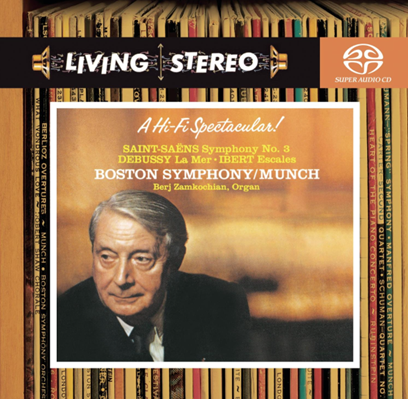
This recording was made in the Boston Symphony Hall, with Berj Zamkochian on the Aeolian-Skinner organ under Charles Munch. Fortuitously I have attended a performance of this piece in the same hall/organ under James Levine. How the organ sounded live, especially in the 2nd and 4th movements is etched indelibly on my aural memory. The interaction of the low bass frequencies of the 4,800 pipe organ and the famous acoustics of the BSH is a pretty tough challenge to reproduce faithfully. The limitless headroom of the REI monoblocks exert magisterial control over the Westminsters’ 15-inch woofers; the wavefront of the organ chords in the beginning of the 4th movement palpably impact and energize my whole body with the REIs driving the Westminster folded bass horn. Is it 100% what I felt in the Boston Symphony Hall? No – I’d be hard pressed to think that ANY system can approach even 85% of that magical experience. Before the REIs started driving my system I’d say I was only 40% there, but now I can confidently say that I’m at least 70% there, which I never thought was possible, transporting me back to a balmy fall Boston night of 2005. Pure magic.
Canteloube: Chants d’Auvergne, Jean-Claude Casadesus, Véronique Gens. NAXOS SACD/DSF
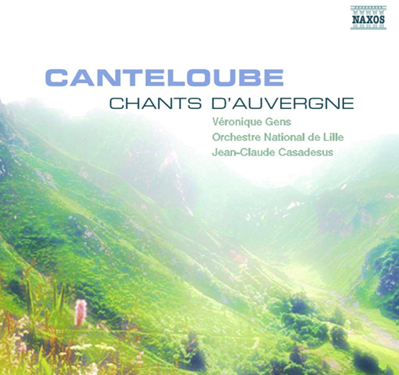
A lovely song cycle sung in Auvergnat, most have at least heard Baïlèro at some point. My favorites here include Passo pel prat and Trois bourrées. Soundstaging and realism are excellent with the REIs running the show, but my subjective impression is of significantly increased emotional involvement. The PRaT of the REI monoblocks in concert with the Horizon DAC and Taiko Extreme server brings this recording to a new level of immersion. Véronique Gens’ gorgeous tone comes across smooth and powerful, with nary a hint of glare or shrillness, rendered with lifelike dynamics and soundstaging at real world front orchestra SPLs by the REI’s masterful control of the Tannoy Westminsters.
In Full Swing, Mark O’Connor’s Hot Swing Trio. Sony Classical SACD/DSF
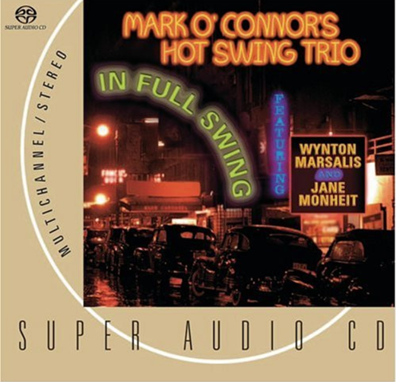
A wonderful recording from 2003, this date between Mark O’Connor’s trio with Wynton Marsalis and Jane Monheit was envisioned as a tribute to Stephane Grappelli, O’Connor’s mentor. On Honeysuckle Rose, the improvements that the REI monoblocks made in the already excellent soundstaging capabilities of my system are clearly on display here, with O’Connor’s violin on the left interweaving with Marsalis’ trumpet slightly center right, and Jane Monheit’s vocal presence very convincingly fleshed out between and about 10’ behind the speaker plane. To be honest, this recording was never one of my favorites before the REIs took their place in my system. Somehow, the flow and rhythmic capabilities of the REIs have taken the emotional connection from this recording to a different level entirely and I find it very hard to tear myself away from listening to every track.
Mahler: Das Lied von der Erde, San Francisco Symphony, Michael Tilson Thomas. SFS Media SACD/DSF
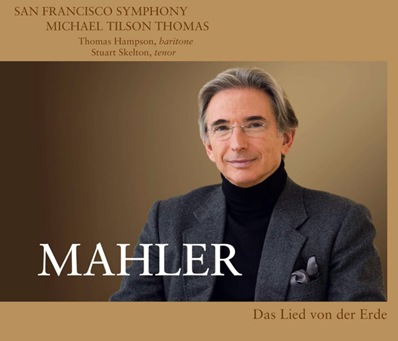
Der Abschied is one of my all time favorite musical passages. There is some controversy about Thomas Hampson’s performance on this recording, but for me MTT’s rendition here is wonderfully evocative and emotional, with wonderful playing from the SFS. The quality of the recording is superlative in DSD.
I’m getting a substantial jump in hall ambience retrieval and the sense of “you are there-ness” with the REIs on this recording. Small sonic details which were previously slightly unnatural and somewhat distracting, like the squeak of leather on chairs, valves on woodwinds, and the rustling of pages, which previously felt like “hi fi features” now seem a natural contribution to the hall ambiance, adding yet another piece to the realistic sonic illusion. This is a substantial leap forward in my system for an amazing performance by MTT/SFS, which I can now enjoy from row C instead of mid-hall, with Stuart Skelton and Thomas Hampson now located about 25’ in front of me, with a palpable illusion of the SFS arrayed behind. Both the clarity and incredible dynamic control of the REIs are on full display here, with an incredibly natural flow of this heart-wrenching piece up to the final “Ewig”, which brings tears to my eyes.
Schoenberg: Gurrelieder, SWR Symphony Orchestra, Michael Gielen. Hänssler Classic SACD/DSF
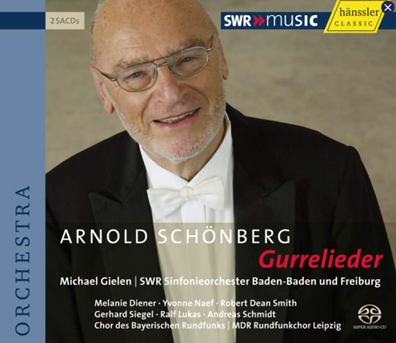
A large orchestral oratorio with Schoenberg trying to “out-Wagner” his idol, this was another challenging recording for my system prior to the arrival of the REI monoblocks. The large dynamic shifts of the exceptionally massive orchestra and choir, with 125 musicians and over 200 choir singers, coupled with the need to maintain appropriate scale and body to the soloists in front, is a true challenge to reproduce. My benchmark for this piece is again with the Boston Symphony Orchestra, where I had the privilege to experience this amazing work live both in the Boston Symphony Hall in February 2006, as well as in Tanglewood in July of that same year. Since then I’ve been striving to recreate the magical experience of this piece in my listening room. Needless to say, with my old amplifier the presentation fell apart if you approached 70-80% of real world SPLs (assuming a front orchestra seat, as is my preference). However, with the REIs the louder passages were almost unrecognizable, they were so much better. Take the climatic “Seht die sonne…” after the relatively quiet sprechstimme of “Herr Gänsefuss, Frau Gänsekraut”; coherence was maintained without any trace of harshness, glare or strain – just monumental peaks of natural sound from the orchestra, choir and soloists as Schoenberg intended.
Update: IC/Speaker Cable reconfiguration
Immediately after my audition, I had embarked on a large solar and batteries project to achieve energy neutrality for my house. As part of the project, a garage subpanel was installed to prepare for EV charging, with 2/2/2/4 SER copper cable feeding a NQ subpanel prepared by KingRex Consulting. I took this opportunity to install 6 direct 10/2 MC solid core copper circuits from the NQ subpanel to the music room.
This resulted in a notable change with the WestminsterLab REI monoblocks that are worth reporting.
As I detailed above, the initial audition setup was performed with short (1-1.5m) balanced interconnects and long (30’) speaker cables. Due to the availability of high quality power near the speaker locations, I could now situate the REIs next to/near the speakers with the rest of the equipment still positioned on the left of the room, with long 30’ XLR ICs and short (4m) biwire speaker cables. All ICs and speaker cables were, and are, made with 12/16/20 Ga Duelund DCA cables.
During the initial audition, the REIs were clearly head and shoulders above my prior reference amp in essentially every facet you could consider. I had already made my decision to purchase based on those very compelling findings.
When my own pair of REI monoblocks finally arrived, I did another head to head comparison against the XA30.8 after an appropriate break in period with 1) the much shorter speaker cables/long balanced ICs; and 2) new dedicated circuits. Both the Pass and the REIs were again evaluated using the same cable and AC receptable combination.
To my great surprise, this not only reconfirmed all of the amazing qualities that were already evident from the initial audition, but the REIs took a huge step forward in this new configuration. The XA30.8 did demonstrate noticeable improvements with the different IC/speaker cable set up and the new dedicated circuits, but was now vastly outclassed by the REIs, which were probably only showing 60% of their true potential during their audition. I have to hand it to Gary and Fred, who were entirely right on the mark when they pointed out that I was leaving a lot of performance on the table with my very long speaker cables!
Side note – As part of my Solaredge system, live power consumption monitoring revealed that the power consumption from the REI monoblocks was approximately 3-4 times LOWER than the Pass it replaced, drawing well under 100W. As someone who is concerned about the climate and environment, this was an unexpected bonus.
Summary:
WestminsterLab REIs are amazing, get them now!
All jokes aside, it boggles my mind how Angus Leung has managed to squeeze this level of performance, power and musicality on the level of the best tube amplifiers into a tiny solid state immaculately machined chassis that one can hold up with one hand (literally). In some ways, the small size and low power draw for this Class A amplifier may counter-intuitively distract from its stunning sonic virtues. Taken solely on its sonic virtues alone – the REI is incomparable. Add in the small size and low power draw, and they are simply one of a kind.
Big thanks for trailblazing this unique or near-unique approach to amplification @lscangus, for introducing this amazing line to the US, @gleeds ; and for convincing me to audition (and subsequently purchase) these amazing monoblocks @LampiNA !
I'd like to conclude with more specific observations on some selected works which exemplified the big leap forward that the REIs brought to my system.
Saint-Saens: Symphony No. 3 “Organ”, Boston Symphony Orchesta, Charles Munch. Living Stereo SACD/DSF

This recording was made in the Boston Symphony Hall, with Berj Zamkochian on the Aeolian-Skinner organ under Charles Munch. Fortuitously I have attended a performance of this piece in the same hall/organ under James Levine. How the organ sounded live, especially in the 2nd and 4th movements is etched indelibly on my aural memory. The interaction of the low bass frequencies of the 4,800 pipe organ and the famous acoustics of the BSH is a pretty tough challenge to reproduce faithfully. The limitless headroom of the REI monoblocks exert magisterial control over the Westminsters’ 15-inch woofers; the wavefront of the organ chords in the beginning of the 4th movement palpably impact and energize my whole body with the REIs driving the Westminster folded bass horn. Is it 100% what I felt in the Boston Symphony Hall? No – I’d be hard pressed to think that ANY system can approach even 85% of that magical experience. Before the REIs started driving my system I’d say I was only 40% there, but now I can confidently say that I’m at least 70% there, which I never thought was possible, transporting me back to a balmy fall Boston night of 2005. Pure magic.
Canteloube: Chants d’Auvergne, Jean-Claude Casadesus, Véronique Gens. NAXOS SACD/DSF

A lovely song cycle sung in Auvergnat, most have at least heard Baïlèro at some point. My favorites here include Passo pel prat and Trois bourrées. Soundstaging and realism are excellent with the REIs running the show, but my subjective impression is of significantly increased emotional involvement. The PRaT of the REI monoblocks in concert with the Horizon DAC and Taiko Extreme server brings this recording to a new level of immersion. Véronique Gens’ gorgeous tone comes across smooth and powerful, with nary a hint of glare or shrillness, rendered with lifelike dynamics and soundstaging at real world front orchestra SPLs by the REI’s masterful control of the Tannoy Westminsters.
In Full Swing, Mark O’Connor’s Hot Swing Trio. Sony Classical SACD/DSF

A wonderful recording from 2003, this date between Mark O’Connor’s trio with Wynton Marsalis and Jane Monheit was envisioned as a tribute to Stephane Grappelli, O’Connor’s mentor. On Honeysuckle Rose, the improvements that the REI monoblocks made in the already excellent soundstaging capabilities of my system are clearly on display here, with O’Connor’s violin on the left interweaving with Marsalis’ trumpet slightly center right, and Jane Monheit’s vocal presence very convincingly fleshed out between and about 10’ behind the speaker plane. To be honest, this recording was never one of my favorites before the REIs took their place in my system. Somehow, the flow and rhythmic capabilities of the REIs have taken the emotional connection from this recording to a different level entirely and I find it very hard to tear myself away from listening to every track.
Mahler: Das Lied von der Erde, San Francisco Symphony, Michael Tilson Thomas. SFS Media SACD/DSF

Der Abschied is one of my all time favorite musical passages. There is some controversy about Thomas Hampson’s performance on this recording, but for me MTT’s rendition here is wonderfully evocative and emotional, with wonderful playing from the SFS. The quality of the recording is superlative in DSD.
I’m getting a substantial jump in hall ambience retrieval and the sense of “you are there-ness” with the REIs on this recording. Small sonic details which were previously slightly unnatural and somewhat distracting, like the squeak of leather on chairs, valves on woodwinds, and the rustling of pages, which previously felt like “hi fi features” now seem a natural contribution to the hall ambiance, adding yet another piece to the realistic sonic illusion. This is a substantial leap forward in my system for an amazing performance by MTT/SFS, which I can now enjoy from row C instead of mid-hall, with Stuart Skelton and Thomas Hampson now located about 25’ in front of me, with a palpable illusion of the SFS arrayed behind. Both the clarity and incredible dynamic control of the REIs are on full display here, with an incredibly natural flow of this heart-wrenching piece up to the final “Ewig”, which brings tears to my eyes.
Schoenberg: Gurrelieder, SWR Symphony Orchestra, Michael Gielen. Hänssler Classic SACD/DSF

A large orchestral oratorio with Schoenberg trying to “out-Wagner” his idol, this was another challenging recording for my system prior to the arrival of the REI monoblocks. The large dynamic shifts of the exceptionally massive orchestra and choir, with 125 musicians and over 200 choir singers, coupled with the need to maintain appropriate scale and body to the soloists in front, is a true challenge to reproduce. My benchmark for this piece is again with the Boston Symphony Orchestra, where I had the privilege to experience this amazing work live both in the Boston Symphony Hall in February 2006, as well as in Tanglewood in July of that same year. Since then I’ve been striving to recreate the magical experience of this piece in my listening room. Needless to say, with my old amplifier the presentation fell apart if you approached 70-80% of real world SPLs (assuming a front orchestra seat, as is my preference). However, with the REIs the louder passages were almost unrecognizable, they were so much better. Take the climatic “Seht die sonne…” after the relatively quiet sprechstimme of “Herr Gänsefuss, Frau Gänsekraut”; coherence was maintained without any trace of harshness, glare or strain – just monumental peaks of natural sound from the orchestra, choir and soloists as Schoenberg intended.
Update: IC/Speaker Cable reconfiguration
Immediately after my audition, I had embarked on a large solar and batteries project to achieve energy neutrality for my house. As part of the project, a garage subpanel was installed to prepare for EV charging, with 2/2/2/4 SER copper cable feeding a NQ subpanel prepared by KingRex Consulting. I took this opportunity to install 6 direct 10/2 MC solid core copper circuits from the NQ subpanel to the music room.
This resulted in a notable change with the WestminsterLab REI monoblocks that are worth reporting.
As I detailed above, the initial audition setup was performed with short (1-1.5m) balanced interconnects and long (30’) speaker cables. Due to the availability of high quality power near the speaker locations, I could now situate the REIs next to/near the speakers with the rest of the equipment still positioned on the left of the room, with long 30’ XLR ICs and short (4m) biwire speaker cables. All ICs and speaker cables were, and are, made with 12/16/20 Ga Duelund DCA cables.
During the initial audition, the REIs were clearly head and shoulders above my prior reference amp in essentially every facet you could consider. I had already made my decision to purchase based on those very compelling findings.
When my own pair of REI monoblocks finally arrived, I did another head to head comparison against the XA30.8 after an appropriate break in period with 1) the much shorter speaker cables/long balanced ICs; and 2) new dedicated circuits. Both the Pass and the REIs were again evaluated using the same cable and AC receptable combination.
To my great surprise, this not only reconfirmed all of the amazing qualities that were already evident from the initial audition, but the REIs took a huge step forward in this new configuration. The XA30.8 did demonstrate noticeable improvements with the different IC/speaker cable set up and the new dedicated circuits, but was now vastly outclassed by the REIs, which were probably only showing 60% of their true potential during their audition. I have to hand it to Gary and Fred, who were entirely right on the mark when they pointed out that I was leaving a lot of performance on the table with my very long speaker cables!
Side note – As part of my Solaredge system, live power consumption monitoring revealed that the power consumption from the REI monoblocks was approximately 3-4 times LOWER than the Pass it replaced, drawing well under 100W. As someone who is concerned about the climate and environment, this was an unexpected bonus.
Summary:
WestminsterLab REIs are amazing, get them now!
All jokes aside, it boggles my mind how Angus Leung has managed to squeeze this level of performance, power and musicality on the level of the best tube amplifiers into a tiny solid state immaculately machined chassis that one can hold up with one hand (literally). In some ways, the small size and low power draw for this Class A amplifier may counter-intuitively distract from its stunning sonic virtues. Taken solely on its sonic virtues alone – the REI is incomparable. Add in the small size and low power draw, and they are simply one of a kind.
Big thanks for trailblazing this unique or near-unique approach to amplification @lscangus, for introducing this amazing line to the US, @gleeds ; and for convincing me to audition (and subsequently purchase) these amazing monoblocks @LampiNA !
Steve Williams
Site Founder, Site Owner, Administrator
When people read testimonials like this the first thing they think is "oh he's drinking the Kool Aid". However the acid test is hearing these amps in your own system and up against your own amps. As I posted yesterday, it is a sobering experience as it quickly dispels all preconceived notions. Enjoy seatrope. They really are an amazing product
Thank you for the wonderful write up seatrope! Angus has told me on several occasions his goal for WestminsterLab is not to be the "biggest but to be the best" No pun on our amplifiers size!
Thank you for confirming the joy you are deriving from your system with the Rei in your system. We are extremely grateful. Also, our thanks to Fred and Rob of Lampi NA as one of our earliest industry colleagues who believed in the sonic qualities of WestminsterLab.
Finally, I'll be checking out some of the recordings you mentioned above as I have been looking to expand my classical playlist
Thank you for confirming the joy you are deriving from your system with the Rei in your system. We are extremely grateful. Also, our thanks to Fred and Rob of Lampi NA as one of our earliest industry colleagues who believed in the sonic qualities of WestminsterLab.
Finally, I'll be checking out some of the recordings you mentioned above as I have been looking to expand my classical playlist
Glug.. glug glug... it's tasty...When people read testimonials like this the first thing they think is "oh he's drinking the Kool Aid". However the acid test is hearing these amps in your own system and up against your own amps. As I posted yesterday, it is a sobering experience as it quickly dispels all preconceived notions. Enjoy seatrope. They really are an amazing product
Hello All,
Shipping of the odds and ends for the Capital Audio Festival finally finished!
The band is back together for CAF in Suite #918
Lampizator NA is bringing their world beating Horizon DAC
Von Schweikert Audio their latest VR-55 Mk2 loudspeakers with actively powered woofers
WestminsterLab Quest balanced preamplifier including (4) channels of Rei Class A Class A power for demonstration in single and bi-amplified configurations
Small Green Computer's US premier of the Sonore "Signature" Rendu Streamer/Renderer and their class leading- i9 sonicTransporter, Roon optimized server
WestminsterLab, MasterBuilt and Final Touch Audio cables will tie the system together
With some 120 rooms this promises to be the best CAF ever. Fred, Rob, Damon, Leif, Andrew and I look forward to seeing you there!
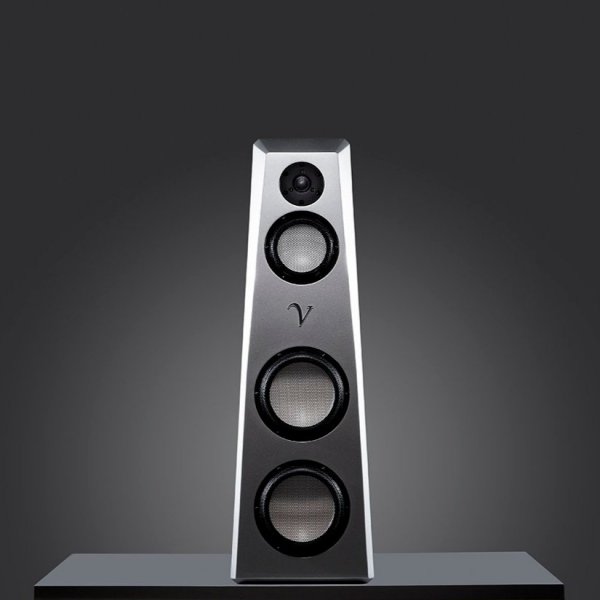
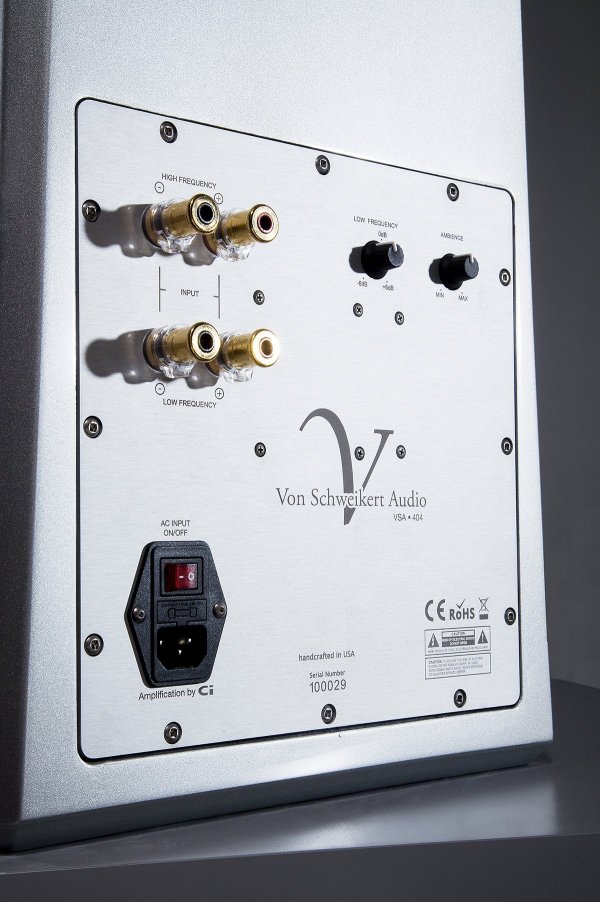
Shipping of the odds and ends for the Capital Audio Festival finally finished!
The band is back together for CAF in Suite #918
Lampizator NA is bringing their world beating Horizon DAC
Von Schweikert Audio their latest VR-55 Mk2 loudspeakers with actively powered woofers
WestminsterLab Quest balanced preamplifier including (4) channels of Rei Class A Class A power for demonstration in single and bi-amplified configurations
Small Green Computer's US premier of the Sonore "Signature" Rendu Streamer/Renderer and their class leading- i9 sonicTransporter, Roon optimized server
WestminsterLab, MasterBuilt and Final Touch Audio cables will tie the system together
With some 120 rooms this promises to be the best CAF ever. Fred, Rob, Damon, Leif, Andrew and I look forward to seeing you there!


Last edited:
Can anyone who's used these amps with extremely sensitive horn speakers 99db + please chime in?
Well, my write up above were with Tannoy Westminsters at 99dB/W/m… not sure if that qualifiesCan anyone who's used these amps with extremely sensitive horn speakers 99db + please chime in?
I did see that. Thanks. It's a great data point. Glad you're enjoying the amps.Well, my write up above were with Tannoy Westminsters at 99dB/W/m… not sure if that qualifies
Similar threads
- Replies
- 32
- Views
- 5K
- Replies
- 12
- Views
- 7K
- Replies
- 1
- Views
- 603
Members online
- zerostargeneral
- JMaudiophile
- Davidny
- dan31
- kswanson27
- Notdead
- Glide3
- Norman Tracy
- Kmac
- rafale
- sandervdp
- PYP
- abeidrov
- KLH007
- beach2mountain
- Jackl3y
- Giotrude2
- matthias
- Johan K
- Nirlin
- kasin
- slowGEEZR
- Sharok
- NigelB
- DonH50
- MusicFellow
- SlapEcho
- pevan
- AudioHedonist
- Igorskich
- jmelm
- Wavetouch
- JRW1971
- tsaett
- pjwd
- Emorante
- l3uzz
- Rexp
- rau
- fizzletop
- willgall
- Whbgarrett
- luca.pelliccioli
- HeavyD
- blackswan
- Aries Cerat
- Imperial
- bcurtis1959
- tng5090
- CKKeung
Total: 926 (members: 58, guests: 868)
| Steve Williams Site Founder | Site Owner | Administrator | Ron Resnick Site Co-Owner | Administrator | Julian (The Fixer) Website Build | Marketing Managersing |















